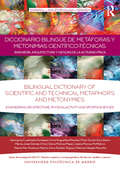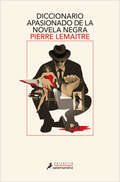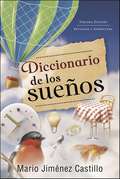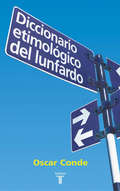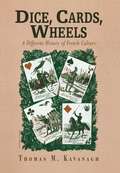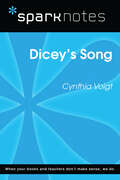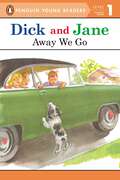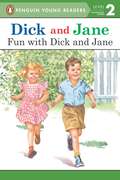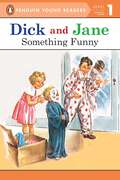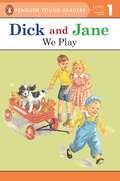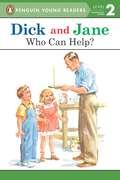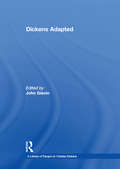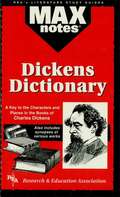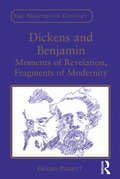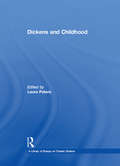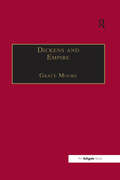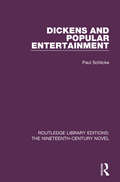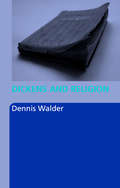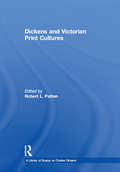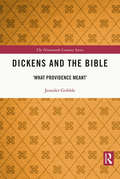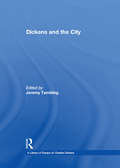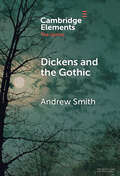- Table View
- List View
Diccionario Bilingüe de Metáforas y Metonimias Científico-Técnicas: Ingeniería, Arquitectura y Ciencias de la Actividad Física
by Georgina Cuadrado EsclapezDiccionario Bilingüe de Metáforas y Metonimias Científico-Técnicas presents the extensive range of metaphoric and metonymic terms and expressions that are commonly used within the fields of science, engineering, architecture and sports science. Compiled by a team of linguists working across a range of technical schools within the Universidad Politécnica de Madrid, this practical dictionary fills a gap in the field of technical language and will be an indispensable reference for students within the fields of science, engineering or sports science seeking to work internationally and for translators and interpreters working in these specialist fields.
Diccionario apasionado de la novela negra
by Pierre LemaitreUna visión completa, absolutamente personal y muy divertida del género negro, por uno de los escritores europeos más prestigiosos y populares. Se la llame negra o policiaca, y se la califique o no «literatura de género» --como si no fuera literatura sin más--, la novela criminal tiene súbditos, reyes, reinas (supuestos o no), capillas, polémicas, egos... pero, sobre todo, novelas que atrapan, impactan, sobrecogen y marcan tanto mentes como épocas. Incondicional de los libros, las películas y las series que describen --o denuncian-- la (mala) marcha del mundo, Pierre Lemaitre, con la libertad, el compromiso y la vivacidad que lo caracterizan, dibuja un panorama internacional personal y divertido, cual biblia erudita, ecléctica y festiva de la novela negra. La crítica ha dicho...«Con la ágil pluma que le conocemos, Pierre Lemaitre comparte en este Diccionario su pasión por la literatura policiaca y la novela negra con un subjetivismo entusiasta y razonado.»RTL «Pierre Lemaitre se apodera de la novela policiaca como novelista y lector, y ofrece su punto de vista con regocijo, asombro y placer. [...] Los aficionados a la novela negra disfrutarán enormemente con esta panorámica.»RTS culture «Uno de esos diccionarios por los que el lector se pasea a placer, antes de leerlo de cabo a rabo. Véanlo como una charla en torno al álbum de fotos de la familia o una invitación a descubrir todo lo que les quedaba por explorar en el continente del noir.»France Inter «Un libro imponente, rebosante de pasión por compartir, que alterna las declaraciones de amor con puyas muy sentidas. Una obra golosa que permite al aficionado, dependiendo de su apetito, devorarla o picar aquí y allá entre los retratos de escritores (de Eric Ambler a Don Winslow, pasando por Jean-Patrick Manchette, Elizabeth George, Donald Westlake y muchos otros) y las revisiones de personajes míticos (a Lemaitre le encanta Colombo), películas y series de referencia (Arresto preventivo, The Wire, etc.).»La Dépêche
Diccionario de los Suenos
by Mario Jimv©nez CastilloConozca el significado de sus sueñosTercera edición revisada y aumentadaEl sueño es una función vital que aligera la carga energética, psicológica y psíquica del cerebro durante su estado consciente. Se calcula que el ser humano sueña entre cuarenta y cincuenta mil horas a lo largo de su existencia, algo así como una novena parte de su vida.En el Diccionario de los sueños encontrará una breve recopilación de las teorías que fundamentan el saber moderno sobre el proceso biológico, las características y los beneficios del sueño, así como más de ocho mil interpretaciones incluyendo palabras poco comunes no encontradas en otros diccionarios.Aprenda el simbolismo contenido en sus sueños y descifre los mensajes que le ayudarán a tomar decisiones importantes en la vida, reconocer oportunidades de trabajo, encontrar el amor y hasta prevenir enfermedades.Discover one of the most complete dream dictionaries, designed to help you decipher all of your dreams—from the simplest to the most abstract. This book presents more than 8,000 dream interpretations, including rare and uncommon words not found in other sources. (This is a Spanish-language book.)
Diccionario etimológico del lunfardo
by Oscar CondeEdición corregida y aumentada. Este diccionario de lunfardo, con casi seis mil entradas, es el único que da cuenta de la etimología de los vocablos y resulta incomparable por su rigor científico, lo que redunda en una mayor claridad y facilita las búsquedas. La palabra lunfardo, que en su origen significó "ladrón" define un extenso vocabulario que nació en las ciudades rioplatenses y se extendió luego al resto del país y a las naciones limítrofes hasta instalarse definitivamente en nuestra habla cotidiana.Las palabras que usamos son mucho más que un medio de comunicación: en su conjunto reflejan un modo de ver el mundo, de categorizar la realidad, de entenderla, en suma, de vivirla. Y sólo nacen cuando el hablante no tiene otras mejores para expresar lo que quiere decir. Los lunfardismos no escapan a esta ley, y constituyen un potente caudal que enriquece nuestro idioma y contribuye de manera indiscutible a construir nuestra identidad. La presente edición, corregida y aumentada, incorpora nuevas acepciones de términos ya registrados y añade voces que no contaban con registro hasta la fecha, como cachengue, ladri, roche, tarlipes y viejazo, entre otras.
Dice, Cards, Wheels
by Thomas M. KavanaghGambling has been a practice central to many cultures throughout history. In Dice, Cards, Wheels, Thomas M. Kavanagh scrutinizes the changing face of the gambler in France over a period of eight centuries, using gambling and its representations in literature as a lens through which to observe French culture. Kavanagh argues that the way people gamble tells us something otherwise unrecognized about the values, conflicts, and cultures that define a period or class. To gamble is to enter a world traced out by the rules and protocols of the game the gambler plays. That world may be an alternative to the established order, but the shape and structure of the game reveal indirectly hidden tensions, fears, and prohibitions.Drawing on literature from the Middle Ages to the present, Kavanagh reconstructs the figure of the gambler and his evolving personae. He examines, among other examples, Bodel's dicing in a twelfth-century tavern for the conversion of the Muslim world; Pascal's post-Reformation redefinition of salvation as the gambler's prize; the aristocratic libertine's celebration of the bluff; and Balzac's, Barbey d'Aurevilly's, and Bourget's nineteenth-century revisions of the gambler.Dice, Cards, Wheels embraces the tremendous breadth of French history and emerges as a broad-ranging study of the different forms of gambling, from the dice games of the Middle Ages to the digital slot machines of the twenty-first century, and what those games tell us about French culture and history.
Dicey's Song (SparkNotes Literature Guide Series)
by SparkNotesDicey's Song (SparkNotes Literature Guide) by Cynthia Voigt Making the reading experience fun! Created by Harvard students for students everywhere, SparkNotes is a new breed of study guide: smarter, better, faster.Geared to what today's students need to know, SparkNotes provides:chapter-by-chapter analysis explanations of key themes, motifs, and symbols a review quiz and essay topics Lively and accessible, these guides are perfect for late-night studying and writing papers.
Dick and Jane: Away We Go (Dick and Jane #Vol. 7)
by Penguin Young ReadersSally said, "Away we go. Away we go in the car. Mother and Father. Dick an Jane. Sally and Tim"
Dick and Jane: Fun with Dick and Jane (Dick and Jane)
by Penguin Young Readers"Look, Jane, " said Dick. "Here is something funny. Can you guess what it is?"
Dick and Jane: Something Funny (Dick and Jane)
by Penguin Young ReadersDick and Jane see something funny. Come and see Spot! Have fun with Dick and Jane as you read along with this sweet and simple story.
Dick and Jane: We Play (Dick and Jane)
by Penguin Young ReadersDick can play. Jane can play. Spot can play, too! Have fun with Dick and Jane as you read along with this sweet and simple story.
Dick and Jane: Who Can Help? (Dick and Jane #Vol. 8)
by Penguin Young ReadersOh, Jane. Oh, Father. Who can come? Who can come and help me?
Dickens
by Fred KaplanKaplan (English, Queens College) provides a full-scale portrait of Dickens and incorporates into the narrative a discussion of the autobiographical basis and significance of his greatest masterpieces.
Dickens Adapted (A Library of Essays on Charles Dickens)
by John GlavinFrom their first appearance in print, Dickens's fictions immediately migrated into other media, and particularly, in his own time, to the stage. Since then Dickens has continuously, apparently inexhaustibly, functioned as the wellspring for a robust mini-industry, sourcing plays, films, television specials and series, operas, new novels and even miniature and model villages. If in his lifetime he was justly called 'The Inimitable', since his death he has become just the reverse: the Infinitely Imitable. The essays in this volume, all appearing within the past twenty years, cover the full spectrum of genres. Their major shared claim to attention is their break from earlier mimetic criteria - does the film follow the novel? - to take the new works seriously within their own generic and historical contexts. Collectively, they reveal an entirely 'other' Dickensian oeuvre, which ironically has perhaps made Dickens better known to an audience of non-readers than to those who know the books themselves.
Dickens Dictionary (MAXNotes Literature Guides)
by Editors of REA Alex PhillipsREA's MAXnotes Dickens Dictionary The MAXNotes Dickens Dictionary is your key to the places and characters in the books of Charles Dickens. This text includes synopses of each of Dickens's works, both major and minor, along with dictionary style entries referring to the body of work as a whole. A must for any student of Dickens.
Dickens Dictionary: An A-Z of England's Greatest Novelist
by John SutherlandFROM THE BOOK JACKET: For fans old and new, this is a fascinating tour through Charles Dickens's novels, in the hands of a master critic and -- interpreter of his work. Oliver Twist... Great Expectations... David Copperfield - all contain riotous fictional worlds that still live and breathe for readers today. But how much do we really know about the dazzling imagination that brought them all into being? To celebrate the bicentenary of the birth of Dickens in 2012, Victorian literature expert John Sutherland has created a gloriously wide-ranging alphabetical companion to Dickens's novels, excavating the hidden links between his characters, themes, and preoccupations, and the minutiae of his endlessly inventive wordplay.
Dickens and Benjamin: Moments of Revelation, Fragments of Modernity (The\nineteenth Century Ser.)
by Gillian PiggottPlacing the works of Charles Dickens and Walter Benjamin in conversation with one another, Gillian Piggott argues that the two writers display a shared vision of modernity. Her analysis of their works shows that both writers demonstrate a decreased confidence in the capacity to experience truth or religious meaning in an increasingly materialist world and that both occupy similar positions towards urban modernity and its effect upon experience. Piggott juxtaposes her exploration of Benjamin's ideas on allegory and messianism with an examination of Dickens's The Old Curiosity Shop, arguing that both writers proffer a melancholy vision of a world devoid of space and time for religious experience, a state of affairs they associate with the onset of industrial capitalism. In Benjamin's The Arcades Project and Dickens's Sketches by Boz and Tale of Two Cities, among other works, the authors converge in their hugely influential treatments of the city as a site of perambulation, creativity, memory, and autobiography. At the same time, both authors relate to the vertiginous, mutable, fast-paced nature of city life as involving a concomitant change in the structure of experience, an alteration that can be understood as a reduction in the capacity to experience fully. Piggott's persuasive analyses enable a reading of Dickens as part of a European, particularly a German, tradition of thinkers and writers of industrialization and modernity. For both Dickens and Benjamin, truth appears only in moments of revelation, in fragments of modernity.
Dickens and Childhood (A Library of Essays on Charles Dickens)
by Laura Peters'No words can express the secret agony of my soul'. Dickens's tantalising hint alluding to his time at Warren's Blacking Factory remains a gnomic statement until Forster's biography after Dickens's death. Such a revelation partly explains the dominance of biography in early Dickens criticism; Dickens's own childhood was understood to provide the material for his writing, particularly his representation of the child and childhood. Yet childhood in Dickens continues to generate a significant level of critical interest. This volume of essays traces the shifting importance given to childhood in Dickens criticism. The essays consider a range of subjects such as the Romantic child, the child and the family, and the child as a vehicle for social criticism, as well as current issues such as empire, race and difference, and death. Written by leading researchers and educators, this selection of previously published articles and book chapters is representative of key developments in this field. Given the perennial importance of the child in Dickens this volume is an indispensable reference work for Dickens specialists and aficionados alike.
Dickens and Empire: Discourses of Class, Race and Colonialism in the Works of Charles Dickens (The Nineteenth Century Series)
by Grace MooreDickens and Empire offers a reevaluation of Charles Dickens's imaginative engagement with the British Empire throughout his career. Employing postcolonial theory alongside readings of Dickens's novels, journalism and personal correspondence, it explores his engagement with Britain's imperial holdings as imaginative spaces onto which he offloaded a number of pressing domestic and personal problems, thus creating an entangled discourse between race and class. Drawing upon a wealth of primary material, it offers a radical reassessment of the writer's stance on racial matters. In the past Dickens has been dismissed as a dogged and sustained racist from the 1850s until the end of his life; but here author Grace Moore reappraises The Noble Savage, previously regarded as a racist tract. Examining it side by side with a series of articles by Lord Denman in The Chronicle, which condemned the staunch abolitionist Dickens as a supporter of slavery, Moore reveals that the tract is actually an ironical riposte. This finding facilitates a review and reassessment of Dickens's controversial outbursts during the Sepoy Rebellion of 1857, and demonstrates that his views on racial matters were a good deal more complex than previous critics have suggested. Moore's analysis of a number of pre- and post-Mutiny articles calling for reform in India shows that Dickens, as their publisher, would at least have been aware of the grievances of the Indian people, and his journal's sympathy toward them is at odds with his vitriolic responses to the insurrection. This first sustained analysis of Dickens and his often problematic relationship to the British Empire provides fresh readings of a number of Dickens texts, in particular A Tale of Two Cities. The work also presents a more complicated but balanced view of one of the most famous figures in Victorian literature.
Dickens and Popular Entertainment (Routledge Library Editions: The Nineteenth-Century Novel #34)
by Paul SchlickeFirst published in 1985. Dickens was a vigorous champion of the right of all men and women to carefree amusements and dedicated himself to the creation of imaginative pleasure. This book represents the first extended study of this vital aspect of Dickens’ life and work, exploring how he channelled his love of entertainment into his artistry. This study offers a challenging reassessment of Nicholas Nickleby, The Old Curiosity Shop and Hard Times. It shows the importance of entertainment to Dickens’ journalism and presents an illuminating perspective on the public readings which dominated the last twelve years of his life. This book will be of interest to students of literature.
Dickens and Religion
by Dennis WalderThe importance of understanding Dickens's religion to obtain a full appreciation of his achievement has long been admitted; but this is the first critical study of the interaction between Dickens's religious beliefs and his creative imagination throughout his career. The novelist's religious beliefs are a pervasive and deeply felt presence in his works even if they are not always clearly thought out or expressed. Too discreet and humane to be as explicit, or as dull, as most of the professedly religious novelists of his time, Dickens nevertheless suggests in his own way a liberal Protestant belief, shot through with Romantic, transcendental yearnings, which undoubtedly appealed to a very wide range of readers. Dickens's religion is shown to be that of a great popular writer, who created a unique kind of fiction, and a unique relationship with his readers, by the absorption and transformation of less respectable contemporary forms, from fairy-tale and German romance to tract and print. Walder's thoroughly researched and lively book provides students of Dickens and the Victorian period with an original perspective on the novelist's methods and attitudes. He offers a judicious and informed exploration of Dickens's obsessive themes, from the 'fall' of innocence in Pickwick Papers, to the search for a religious 'answer' in Little Dorrit. Each chapter focuses upon the striking congruences revealed between individual novels, or groups of novels, and particular religious themes. The views expressed in Dickens's lesser fiction and non-fiction are drawn on throughout, as are those in the influential contemporary press.
Dickens and Victorian Print Cultures (A Library of Essays on Charles Dickens)
by Robert L. PattenThis volume places Dickens at the centre of a dynamic and expanding Victorian print world and tells the story of his career against a background of options available to him. The collection describes a world animated by outpourings of print materials: books, serials, newspapers, periodicals, libraries, paintings and prints, parodies and plagiarisms, censorship, advertising, as well as theatre and other entertainment, and celebrity. It also shows this period as driven by a growing and more literate population, and undergirded by a general conviction that writing was a crucial component of governance and civic culture. The extensive introduction and selected articles anchor Dickens's attempts to establish better conditions for writers regarding copyright protection, pay, status, recognition, and effectiveness in altering public policy. They speak about Dickens's life as playwright, journalist, novelist, editor, magazine publisher, theatrical producer, actor, lecturer, reader of his own works, supporter of charities for impoverished authors and fallen women, exponent of a morality of Christian compassion and domestic affections sometimes put into question by his own actions, proponent and critic of British nationalism, and champion of education for all. This selection of essays and articles from previously published accounts by internationally renowned scholars is of interest to all students and professionals who are fascinated by the composition, manufacture, finance, formats, pictorializations, sales, advertising and influence of Dickens's writing.
Dickens and the Bible: 'What Providence Meant' (ISSN)
by Jennifer GribbleAt a time when biblical authority was under challenge from the Higher Criticism and evolutionary science, ‘what providence meant’ was the most keenly contested of questions. This book takes up the controversial subject of Dickens and religion, and offers a significant contribution to the interdisciplinary area of religion and literature. In a close study of major novels, it argues that networks of biblical allusion reveal the Judeo-Christian grand narrative as key to his development as a writer, and as the ontological ground on which he stands to appeal to ‘the conscience of a Christian people’. Engaging the biblical narrative in dialogue with other contemporary narratives that concern themselves with origins, destinations, and hermeneutic decipherments, the inimitable Dickens affirms the Bible’s still-active role in popular culture. The providential thinking of two twentieth-century theorists, Bakhtin and Ricoeur, sheds light on an exploration of Dickens’s narrative theology.
Dickens and the Bible: 'What Providence Meant' (The Nineteenth Century Series)
by Jennifer GribbleAt a time when biblical authority was under challenge from the Higher Criticism and evolutionary science, ‘what providence meant’ was the most keenly contested of questions. This book takes up the controversial subject of Dickens and religion, and offers a significant contribution to the interdisciplinary area of religion and literature. In a close study of major novels, it argues that networks of biblical allusion reveal the Judeo-Christian grand narrative as key to his development as a writer, and as the ontological ground on which he stands to appeal to ‘the conscience of a Christian people’. Engaging the biblical narrative in dialogue with other contemporary narratives that concern themselves with origins, destinations, and hermeneutic decipherments, the inimitable Dickens affirms the Bible’s still-active role in popular culture. The providential thinking of two twentieth-century theorists, Bakhtin and Ricoeur, sheds light on an exploration of Dickens’s narrative theology.
Dickens and the City: Allegory And Literature Of The City (A Library of Essays on Charles Dickens)
by Jeremy TamblingDickens's relationship to cities is part of his modernity and his enduring fascination. How he thought about, grasped and conceptualised the rapidly expanding and anonymous urban scene are all fascinating aspects of a critical debate which, starting virtually from Dickens's own time, has become more and more active and questioning of the significance of that new thing, the unknown and unknowable, city. Although Dickens was influenced by several European and American cities, the most significant city for Dickens was London, the city he knew as a boy in the 1820s and which developed in his lifetime to become the finance and imperial capital of the nineteenth-century. His sense of London as monumental and fashionable, modern and anachronistic, has generated a large number of writings and critical approaches: Marxist, sociological, psychoanalytic and deconstructive. Dickens looks at the city from several aspects: as a place bringing together poverty and riches; as the place of the new and of chance and coincidence, and of secret lives exposed by the special figure of the detective. Another crucial area of study is the relationship of the city to women, and women's place in the city, as well as the way Dickens's London matches up with other visual representations. This anthology of criticism surveys the field and is a major contribution to the study of cities, city culture, modernity and Dickens. It brings together key previously published articles and essays and features a comprehensive bibliography of work which scholars can continue to explore.
Dickens and the Gothic (Elements in the Gothic)
by Andrew SmithDickens and the Gothic provides a critical focus on representations of social and psychological entrapment which demonstrates how Dickens employs the Gothic to evaluate how institutions and formations of history impinge on the individual. An analysis of these forms of Gothic entrapment reveals how these institutions and representations of public and personal history function Gothically in Dickens, because they hold back other, putatively reformist, ambitions. To be trapped in an institution such as a prison, or by the machinations of a law court, or haunted by history, or to be haunted by ghosts, represent forms of Gothic entrapment which this study examines both psychologically and sociologically.
